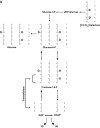Additional evidence that transaldolase exchange, isotope discrimination during the triose-isomerase reaction, or both occur in humans: effects of type 2 diabetes
- PMID: 19366865
- PMCID: PMC2699876
- DOI: 10.2337/db08-1300
Additional evidence that transaldolase exchange, isotope discrimination during the triose-isomerase reaction, or both occur in humans: effects of type 2 diabetes
Abstract
Objective: To determine whether deuterium enrichment on carbons 5 and 3 (C5/C3) in plasma glucose is influenced by processes other than gluconeogenesis and, if so, whether these processes are altered by type 2 diabetes.
Research design and methods: In this study, 10 obese diabetic and 10 obese nondiabetic subjects were infused intravenously with [3,5-(2)H(2)] galactose enriched at a C5-to-C3 ratio of 1.0 as well as the enrichment of deuterium on C5 and C3 of plasma glucose, measured with nuclear magnetic resonance using the acetaminophen glucuronide method.
Results: The ratio of deuterium enrichment on C5 and C3 of glucose was <1 (P < 0.001) in all of the diabetic and nondiabetic subjects, resulting in a means +/- SE C5-to-C3 ratio that did not differ between groups (0.81 +/- 0.01 vs. 0.79 +/- 0.01, respectively).
Conclusions: That the C5-to-C3 glucose ratio is <1 indicates that transaldolase exchange, selective retention of deuterium at the level of the triose-isomerase reaction, or both occur in humans. This also indicates that the net effect of these processes on the C5-to-C3 ratio is the same in people with and without type 2 diabetes. The possible effects of transaldolase exchange or selective retention of deuterium (or tritium) at the level of the triose-isomerase reaction on tracee labeling and tracer metabolism should be considered when the deuterated water method is used to measure gluconeogenesis or [3-(3)H] glucose is used to measure glucose turnover in humans.
Figures




Similar articles
-
Effects of transaldolase exchange on estimates of gluconeogenesis in type 2 diabetes.Am J Physiol Endocrinol Metab. 2013 Aug 15;305(4):E465-74. doi: 10.1152/ajpendo.00245.2013. Epub 2013 Jun 4. Am J Physiol Endocrinol Metab. 2013. PMID: 23736541 Free PMC article.
-
Evidence that processes other than gluconeogenesis may influence the ratio of deuterium on the fifth and third carbons of glucose: implications for the use of 2H2O to measure gluconeogenesis in humans.Diabetes. 2008 Jan;57(1):50-5. doi: 10.2337/db07-0694. Epub 2007 Oct 12. Diabetes. 2008. PMID: 17934142
-
Transaldolase exchange and its effects on measurements of gluconeogenesis in humans.Am J Physiol Endocrinol Metab. 2011 Feb;300(2):E296-303. doi: 10.1152/ajpendo.00403.2010. Epub 2010 Nov 9. Am J Physiol Endocrinol Metab. 2011. PMID: 21062960 Free PMC article.
-
Interaction between the pentose phosphate pathway and gluconeogenesis from glycerol in the liver.J Biol Chem. 2014 Nov 21;289(47):32593-603. doi: 10.1074/jbc.M114.577692. Epub 2014 Oct 6. J Biol Chem. 2014. PMID: 25288790 Free PMC article.
-
Demonstration of glucose-6-phosphate hydrogen 5 enrichment from deuterated water by transaldolase-mediated exchange alone.Magn Reson Med. 2016 Apr;75(4):1781-6. doi: 10.1002/mrm.25749. Epub 2015 May 20. Magn Reson Med. 2016. PMID: 25995077
Cited by
-
Pathogenesis of prediabetes: role of the liver in isolated fasting hyperglycemia and combined fasting and postprandial hyperglycemia.J Clin Endocrinol Metab. 2013 Mar;98(3):E409-17. doi: 10.1210/jc.2012-3056. Epub 2013 Jan 23. J Clin Endocrinol Metab. 2013. PMID: 23345093 Free PMC article.
-
Pathogenesis of fasting and postprandial hyperglycemia in type 2 diabetes: implications for therapy.Diabetes. 2010 Nov;59(11):2697-707. doi: 10.2337/db10-1032. Epub 2010 Aug 12. Diabetes. 2010. PMID: 20705776 Free PMC article.
-
Effects of transaldolase exchange on estimates of gluconeogenesis in type 2 diabetes.Am J Physiol Endocrinol Metab. 2013 Aug 15;305(4):E465-74. doi: 10.1152/ajpendo.00245.2013. Epub 2013 Jun 4. Am J Physiol Endocrinol Metab. 2013. PMID: 23736541 Free PMC article.
-
Use of (2)H(2)O for estimating rates of gluconeogenesis: determination and correction of error due to transaldolase exchange.Am J Physiol Endocrinol Metab. 2012 Dec 1;303(11):E1304-12. doi: 10.1152/ajpendo.00306.2012. Epub 2012 Oct 2. Am J Physiol Endocrinol Metab. 2012. PMID: 23032685 Free PMC article.
-
Evidence for transaldolase activity in the isolated heart supplied with [U-13C3]glycerol.J Biol Chem. 2013 Feb 1;288(5):2914-22. doi: 10.1074/jbc.M112.409441. Epub 2012 Dec 12. J Biol Chem. 2013. PMID: 23235149 Free PMC article.
References
-
- Adkins A, Basu R, Persson M, Dicke B, Shah P, Vella A, Schwenk WF, Rizza R: Higher insulin concentrations are required to suppress gluconeogenesis than glycogenolysis in nondiabetic humans. Diabetes 2003; 52: 2213– 2220 - PubMed
-
- Basu R, Chandramouli V, Dicke B, Landau B, Rizza R: Obesity and type 2 diabetes impair insulin-induced suppression of glycogenolysis as well as gluconeogenesis. Diabetes 2005; 54: 1942– 1948 - PubMed
-
- Boden G, Chen X, Stein TP: Gluconeogenesis in moderately and severely hyperglycemic patients with type 2 diabetes mellitus. Am J Physiol Endocrinol Metab 2001; 280: E23– E30 - PubMed
-
- Gastaldelli A, Baldi S, Pettiti M, Toschi E, Camastra S, Natali A, Landau BR, Ferrannini E: Influence of obesity and type 2 diabetes on gluconeogenesis and glucose output in humans: a quantitative study. Diabetes 2000; 49: 1367– 1373 - PubMed
Publication types
MeSH terms
Substances
Grants and funding
LinkOut - more resources
Full Text Sources
Medical
Miscellaneous

